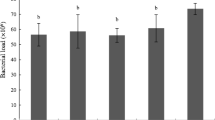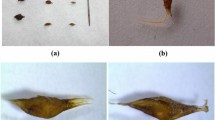Summary
The biology of the oriental vermicomposting species, Perionyx excavatus, is poorly understood. Quantitative observations were made at 25°C in urine free cattle manure in order to study the growth of this species. The rate of maturation and cocoon production were studied under conditions of favourable moisture and nutrition over a period of 250 days. The results obtained showed that while P. excavatus grows relatively slowly compared to other vermicomposting species, it attains sexual maturity much earlier and maintains a relatively high cocoon production rate. The study revealed that copulation is not a prerequisite for production of viable cocoons, indicating that P. excavatus may be parthenogenetic and possibly capable of alternating between modes of reproduction.
Similar content being viewed by others
References
Beddard FE (1886) Descriptions of some new or little-known earthworms together with an account of the variations in structure exhibited by Perionyx excavatus. Proc Zool Soc 21:298–313
Hanumante MM (1975) On the anatomy of the reproductive system of the earthworm Perionyx excavatus. Marathwada Univ J Sci 15:193–197
Jaenike J, Selander RK (1979) Evolution and ecology of parthenogenesis in earthworms. Am Zool 19:729–737
Kale RD, Bano K, Krishnamoorthy RU (1982) Potential of Perionyx excavatus for utilizing organic wastes. Pedobiologia 23:419–425
Knieriemen D (1984) Biomassegewinnung durch Vermehrung wärmeliebender Regenwurmarten. Doctorate thesis JustusLiebig-Universität, Giessen, FRG
Loehr RC, Martin JH, Neuhauser EF, Malecki MR (1984) Waste management using earthworms — engineering and scientific relationships. Project report ISP-8016764, National Science Foundation, Washington DC
Neuhauser EF, Kaplan DL, Hartenstein R (1979) Life history of the earthworm Eudrilus eugeniae. Rev Ecol Biol Sol 16:525–534
Perrier E (1872) Recherches pour servir a l'histoire des lombriciens terrestres. Nouv Arch Mus Hist Natl Paris 8:126–198
Vail VA (1974) Observations on the hatching of Eisenia fetida and Bimastos tumidus. Bull Tall Timbers Res St 16:1–8
Venter JM, Reinecke AJ (1988) The life-cycle of the compost worm Eisenia fetida (Oligochaeta). S Afr J Zool 23:161–165
Viljoen SA, Reinecke AJ (1989) The life-cycle of the African nightcrawler, Eudrilus eugeniae (Oligochaeta). S Afr J Zool 24:27–32
Author information
Authors and Affiliations
Rights and permissions
About this article
Cite this article
Reinecke, A.J., Hallatt, L. Growth and cocoon production of Perionyx excavatus (Oligochaeta). Biol Fert Soils 8, 303–306 (1989). https://doi.org/10.1007/BF00263159
Received:
Issue Date:
DOI: https://doi.org/10.1007/BF00263159




